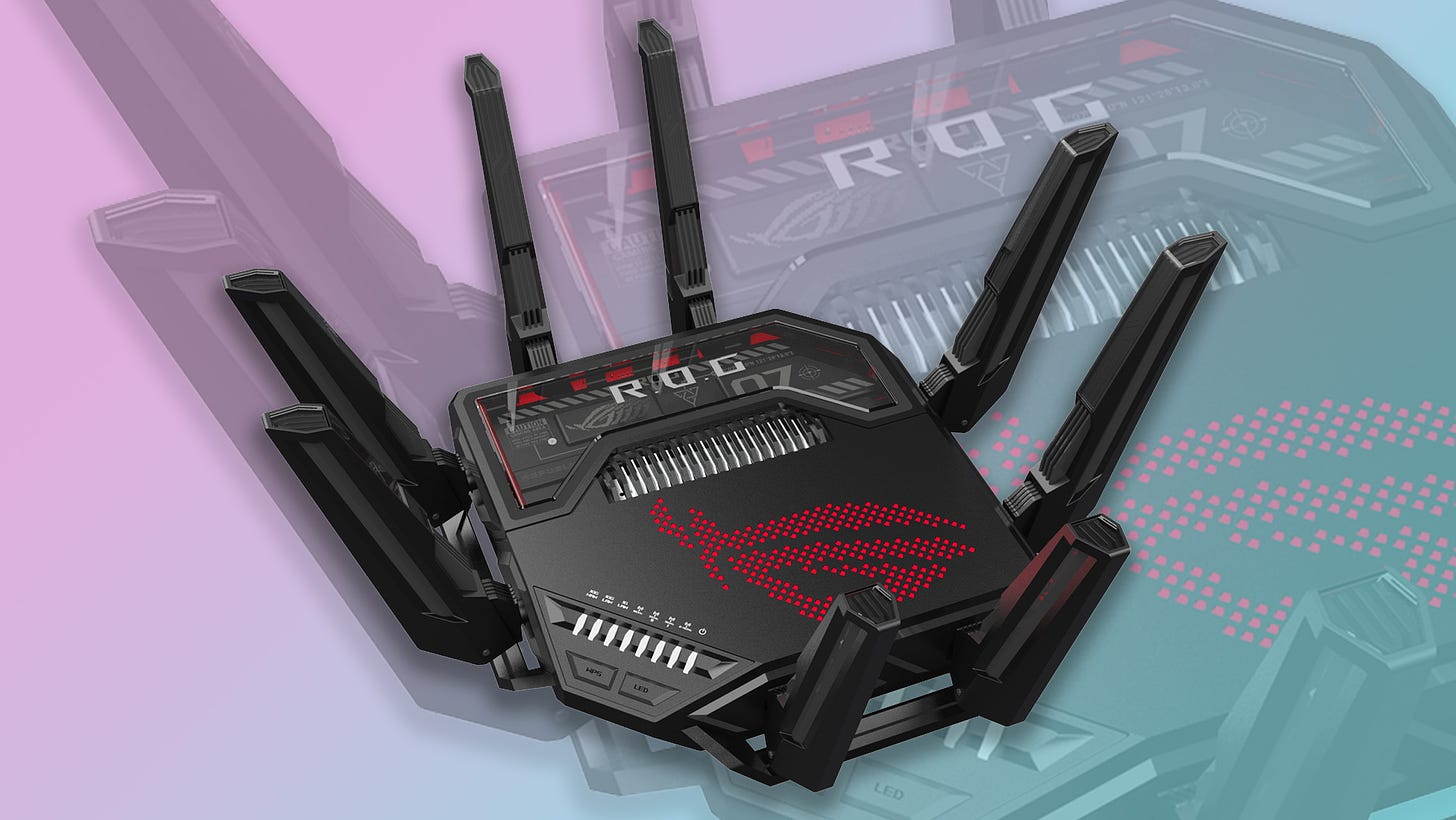
The WiFi 7 Asus ROG Rapture GT-BE98 is a retro cool router at CES 2023
The quad-band router promises more throughput than any router on the market
➡️ The Shortcut Skinny: a fast WiFi headcrab
📶 The Asus ROG Rapture GT-BE98 brings Asus’ gaming prowess to WiFi 7
🏎️ Asus claims up to 25,000Gbps max combined throughput
🔥 The router has three 10Gbps ethernet ports
👍 Full specs are unknown, but Asus knows how to make a great router
If there’s a new WiFi standard, Asus is there with something that supports it as soon as can be, and while the Asus ROG Rapture GT-BE98 isn’t quite the first WiFi 7 gaming router out into the world this time – that honor goes to TP-Link’s Archer BE900, the November announcement of which which preceded the TP-Link WiFi 7 extenders we heard about this morning – it’s one of the fastest, and certainly the head-crabbiest. And none of us will get to use it to its full potential for at least a year, but that may not matter – after all, CES is about the future.
Asus ROG Rapture GT-BE98 known specs
The GT-BE98 is a quad-band WiFi 7 router capable – according to Asus – of up to 25,000Mbps, though that’s combined throughput on all its spatial streams (WiFi 7 supports up to 16 spatial streams compared to the 12 of WiFi 6E).
Still, a single WiFi 7-capable phone or laptop could theoretically pull 2.4Gbps on a single stream. Because most client devices these days use 2 streams though, that means a phone could potentially pull down a hefty chunk of a 5Gbps connection. Neat! But it gets better.
WiFi 7 – and the GT-BE98 by extension – supports multi-linking, which is like wireless link aggregation. In other words, a single device could connect to this router across multiple bands (say, one of the two WiFi 5 bands and the WiFi 6 band), massively increasing throughput. That’s not unique to this router, though.
The GT-BE98 also has three 10Gbps ethernet ports. That’s a nice bump from the two 10Gbps ports on the GT-AXE16000 that preceded it and vastly better than the single 2.5Gbps ethernet of the GT-AXE11000 WiFi 6E router before that.
Better than the TP-Link Archer BE900?
Will it be faster than the Archer BE900? We won’t know for a while. Both companies make great routers, and much about their internals is likely the same. In the short term, TP-Link’s machine will be nice to have if you own a lot of 2.5Gbps gear, but in the long term, the extra 10Gbps ethernet port of the GT-BE98 could be nicer for the tech-forward early adopter types this sort of thing appeals to.
It’s worth noting, at least, that the GT-BE98 has a quad-core 2.6GHz processor driving it, while the Archer BE900’s processor is unknown. If the former’s CPU is faster, that could clinch it for Asus’ new beefsteak of a networking box. They’re probably using the same chipset, though.
Suffice to say that both will probably make our shortlist for the best WiFi router when they come later this year.
A retro-cool take on router design
Finally, while it always feels a little silly to discuss the looks of a router, Asus clearly wants us to, and that’s fine by me because I think this might be one of the coolest-looking gaming routers in years. The ROG Rapture series has felt like it’s trying to do something with its design and never quite reaching whatever that is, and I think with the GT-BE98, it’s found that thing. It looks like a late-80s boombox or something from Nothing designers behind the Ear (stick) earbuds and the Nothing phone.
Why does WiFi 7 matter?
Quick primer here: WiFi 7 is the next iteration of WiFi, so new that not a single device you own, or will own in the next year or so, uses it. But it’ll be important. When WiFi 6E routers hit, they were the first ones to use the 6GHz band, which is a wide open wireless spectrum that was previously banned for use by consumer devices, and that ban has been lifted.
This band matters because it’s much broader and faster than the usable space on the 5GHz band, and WiFi 6E lets us use big chunks of that, giving your phone or laptop with a WiFi 6E wireless card the technical ability to download data faster than your gigabit connection can pump it.
WiFi 7 doubles those chunks, giving us three 320MHz channels. Confused? Here’s an analogy: if your network data is a car, then the wireless band is the highway, and the channel is a lane. In this analogy, WiFi 7 lets you drive the biggest car on the widest lane on the most gigantic highway.




